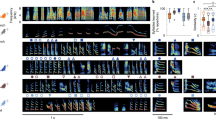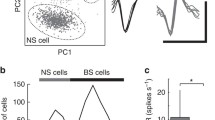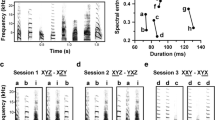Abstract
Neurons in the song system nuclei of songbirds exhibit a strong preference for the sound of the bird’s own song relative to that of conspecific songs. This selectivity is observed in the high vocal center and the nucleus interface of the nidopallium, two song nuclei that receive input from the bird’s auditory system. To investigate the role of the auditory system in generating the selective responses observed in the song system, we recorded auditory responses in the zebra finch primary auditory forebrain, field L, and in a secondary auditory area, the caudal mesopallium. Field L and caudal mesopallium project directly or indirectly to the high vocal center and nucleus interface of the nidopallium and are presumed to provide substantial auditory input to the song system. We found that, on average, neurons in field L and caudal mesopallium did not show positive selective responses for the bird’s own song or tutor song relative to conspecific song. Moreover, there were no particular sub-areas in the auditory telencephalon that were relatively more selective than the average. The selectivity for the bird’s own song would therefore be restricted to song nuclei and would arise in one processing step, potentially found at the interface between the auditory and the song systems.













Similar content being viewed by others
Abbreviations
- BOS:
-
bird’s own song
- CM:
-
caudal mesopallium (older term: caudal hyperstriatum ventrale or cHV)
- Con:
-
conspecific song
- HVC:
-
high vocal center
- LMAN:
-
lateral magnocellular nucleus of the anterior nidopallium (older term: lateral magnocellular nucleus of the anterior neostriatum)
- LPS:
-
pallial-subpallial lamina (older term: lamina medularis dorsalis or LMD)
- NCM:
-
caudal medial nidopallium (older term: caudo-medial neostriatum)
- NIf:
-
nucleus interface of the nidopallium (older term: nucleus interface of the neostriatum)
- RA:
-
robust nucleus of arcopallium (older term: robust nucleus of the archistriatum)
- Rev:
-
reverse BOS
- Revorder:
-
reverse order of BOS
- Uva:
-
nucleus uvaeformis of the thalamus
References
Bonke D, Scheich H, Langner G (1979) Responsiveness of units in the auditory neostriatum of the guinea fowl (Numida meleagris) to species-specific calls and synthetic stimuli. I. Tonotopy and functional zones of field L. J Comp Physiol 132:243–255
Brenowitz EA (1991) Altered perception of species-specific song by female birds after lesions of a forebrain nucleus. Science 251:303–305
Brenowitz EA, Margoliash D, Nordeen KW (1997) An introduction to birdsong and the avian song system. J Neurobiol 33:495–500
Burt JM, Lent KL, Beecher MD, Brenowitz EA (2000) Lesions of the anterior forebrain song control pathway in female canaries affect song perception in an operant task. J Neurobiol 42:487
Chew SJ, Mello C, Nottebohm F, Jarvis E, Vicario DS (1995) Decrements in auditory responses to a repeated conspecific song are long-lasting and require two periods of protein synthesis in the songbird forebrain. Proc Natl Acad Sci USA 92:3406–3410
Chew SJ, Vicario DS, Nottebohm F (1996) A large-capacity memory system that recognizes the calls and songs of individual birds. Proc Natl Acad Sci USA 93:1950–1955
Coleman MJ, Mooney R (2002) Source of auditory input to the songbird nucleus HVc revealed by pairwise recordings in Nif and HVc. Soc Neurosci Prog 588
Dave AS, Margoliash D (2000) Song replay during sleep and computational rules for sensorimotor vocal learning. Science 290:812–816
Dave AS, Yu AC, Margoliash D (1998) Behavioral state modulation of auditory activity in a vocal motor system. Science 282:2250–2254
Doupe AJ (1997) Song- and order-selective neurons in the songbird anterior forebrain and their emergence during vocal development. J Neurosci 17:1147–1167
Doupe AJ, Konishi M (1991) Song-selective auditory circuits in the vocal control system of the zebra finch. Proc Natl Acad Sci USA 88:11339–11343
Eales LA (1985) Song learning in zebra finches: some effects of song model availability on what is learnt and when. Anim Behav 33:1293–1300
Fortune ES, Margoliash D (1992) Cytoarchitectonic organization and morphology of cells of the field L complex in male zebra finches (Taenopygia guttata). J Comp Neurol 325:388–404
Fortune ES, Margoliash D (1995) Parallel pathways and convergence onto HVc and adjacent neostriatum of adult zebra finches (Taenopygia guttata). J Comp Neurol 360:413–441
Gentner TQ, Margoliash D (2003) Neuronal populations and single cells representing learned auditory objects. Nature 424:669–674
Gentner TQ, Hulse SH, Bentley GE, Ball GF (2000) Individual vocal recognition and the effect of partial lesions to HVc on discrimination, learning, and categorization of conspecific song in adult songbirds. J Neurobiol 42:117–133
Gentner TQ, Hulse SH, Duffy D, Ball GF (2001) Response biases in auditory forebrain regions of female songbirds following exposure to sexually relevant variation in male song. J Neurobiol 46:48–58
Grace JA, Amin N, Singh NC, Theunissen FE (2003) Selectivity for conspecific song in the zebra finch auditory forebrain. J Neurophysiol 89:472–487
Immelmann K (1969) Song development in the zebra finch and other estrildid finches. In: Hinde RA (ed) Bird vocalizations. Cambridge University Press, London, pp 61–74
Janata P, Margoliash D (1999) Gradual emergence of song selectivity in sensorimotor structures of the male zebra finch song system. J Neurosci 19:5108–5118
Langner G, Bonke D, Scheich H (1981) Neuronal discrimination of natural and synthetic vowels in field L of trained mynah birds. Exp Brain Res 43:11–24
Leppelsack HJ, Vogt M (1976) Responses of auditory neurons in the forebrain of a songbird to stimulation with species-specific sounds. J Comp Neurol 107:263–274
Lewicki MS, Arthur BJ (1996) Hierarchical organization of auditory temporal context sensitivity. J Neurosci 16:6987–6998
Lewicki MS, Konishi M (1995) Mechanisms underlying the sensitivity of songbird forebrain neurons to temporal order. Proc Natl Acad Sci USA 92:5582–5586
MacDougall-Shackleton SA, Hulse SH, Ball GF (1998) Neural bases of song preferences in female zebra finches (Taenopygia guttata). Neuroreport 9:3047–3052
Margoliash D (1986) Preference for autogenous song by auditory neurons in a song system nucleus of the white-crowned sparrow. J Neurosci 6:1643–1661
Margoliash D (2002) Evaluating theories of bird song learning: implications for future directions. J Comp Physiol A 188:851–866
Margoliash D, Fortune ES (1992) Temporal and harmonic combination-sensitive neurons in the zebra finch’s HVc. J Neurosci 12:4309–4326
Marler P (1997) Three models of song learning: evidence from behavior. J Neurobiol 33:501–516
McCasland JS, Konishi M (1981) Interactions between auditory and motor activities in an avian song control nucleus. Proc Natl Acad Sci USA 78:7815–7819
Mello CV (2002) Mapping vocal communication pathways in birds with inducible gene expression. J Comp Physiol A 188:943–959
Mello CV, Nottebohm F, Clayton D (1995) Repeated exposure to one song leads to a rapid and persistent decline in an immediate early gene’s response to that song in zebra finch telencephalon. J Neurosci 15:6919–6925
Mello CV, Vates G, Okuhata S, Nottebohm F (1998) Descending auditory pathways in the adult male zebra finch. J Comp Neurol 395:137–160
Mooney R (2000) Different subthreshold mechanisms underlie song selectivity in identified HVc neurons of the zebra finch. J Neurosci 20:5420–5436
Mooney R, Rosen MJ, Sturdy CB (2002) A bird’s eye view: top down intracellular analyses of auditory selectivity for learned vocalizations. J Comp Physiol A 188:879–895
Nottebohm F, Alvarez-Buylla A, Cynx J, Kirn J, Ling CY, Nottebohm M, Suter R, Tolles A, Williams H (1990) Song learning in birds: the relation between perception and production. Philos Trans R Soc London Ser B 329:115–124
Rauske PL, Shea SD, Margoliash D (2003) State and neuronal class-dependent reconfiguration in the avian song system. J Neurophysiol 89:1688–1701
Scharff C, Nottebohm F, Cynx J (1998) Conspecific and heterospecific song discrimination in male zebra finches with lesions in the anterior forebrain pathway. J Neurobiol 36:81–90
Singh NC, Theunissen FE (2003) Modulation spectra of natural sounds and ethological theories of auditory processing. JASA 114:3394–3411
Solis MM, Doupe AJ (1997) Anterior forebrain neurons develop selectivity by an intermediate stage of birdsong learning. J Neurosci 17:6447–6462
Solis MM, Doupe AJ (1999) Contributions of tutor and bird’s own song experience to neural selectivity in the songbird anterior forebrain. J Neurosci 19:4559–4584
Stripling R, Volman S, Clayton D (1997) Response modulation in the zebra finch caudal neostriatum: relationship to nuclear gene regulation. J Neurosci 17:3883–3893
Theunissen FE, Doupe AJ (1998) Temporal and spectral sensitivity of complex auditory neurons in the nucleus HVc of male zebra finches. J Neurosci 18:3786–3802
Troyer TW, Doupe AJ (2000) An associational model of birdsong sensorimotor learning. I. Efference copy and the learning of song syllables. J Neurophysiol 84:1204–1223
Vates GE, Broome BM, Mello CV, Nottebohm F (1996) Auditory pathways of caudal telencephalon and their relation to the song system of adult male zebra finches (Taenopygia guttata). J Comp Neurol 366:613–642
Volman SF (1993) Development of neural selectivity for birdsong during vocal learning. J Neurosci 13:4737–4747
Volman SF (1996) Quantitative assessment of song-selectivity in the zebra finch “high vocal center”. J Comp Physiol 178:849–862
Wild JM (1994) Visual and somatosensory inputs to the avian song system via nucleus uvaeformis (Uva) and a comparison with the projections of a similar thalamic nucleus in a nonsongbird, Columba livia. J Comp Neurol 349:512–535
Williams HW (1990) Models for song learning in the zebra finch: fathers or others? Anim Behav 39:745–757
Williams H, Nottebohm F (1985) Auditory responses in avian vocal motor neurons: a motor theory for song perception in birds. Science 229:279–282
Acknowledgements
We thank S. Woolley and T. Fremouw for valuable comments on the manuscript. This work was supported by research grants from the NIMH to FET. All animal procedures were approved by Animal Care and Use Committee at UC Berkeley.
Author information
Authors and Affiliations
Corresponding author
Additional information
New avian brain terminology has been used in this paper (http://www.avianbrain.org). Older terms are given in parentheses in the list of abbreviations
Rights and permissions
About this article
Cite this article
Amin, N., Grace, J.A. & Theunissen, F.E. Neural response to bird’s own song and tutor song in the zebra finch field L and caudal mesopallium. J Comp Physiol A 190, 469–489 (2004). https://doi.org/10.1007/s00359-004-0511-x
Received:
Revised:
Accepted:
Published:
Issue Date:
DOI: https://doi.org/10.1007/s00359-004-0511-x




